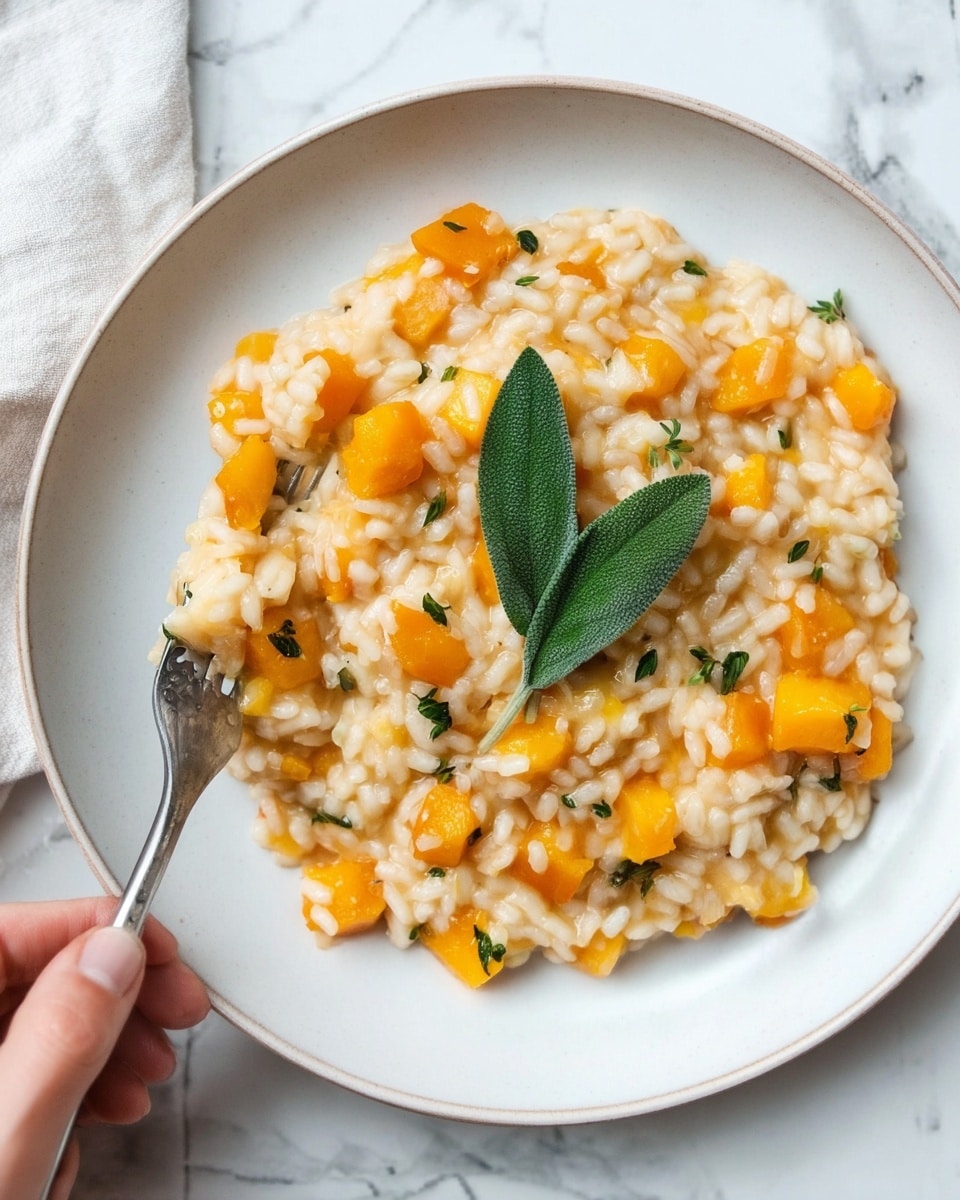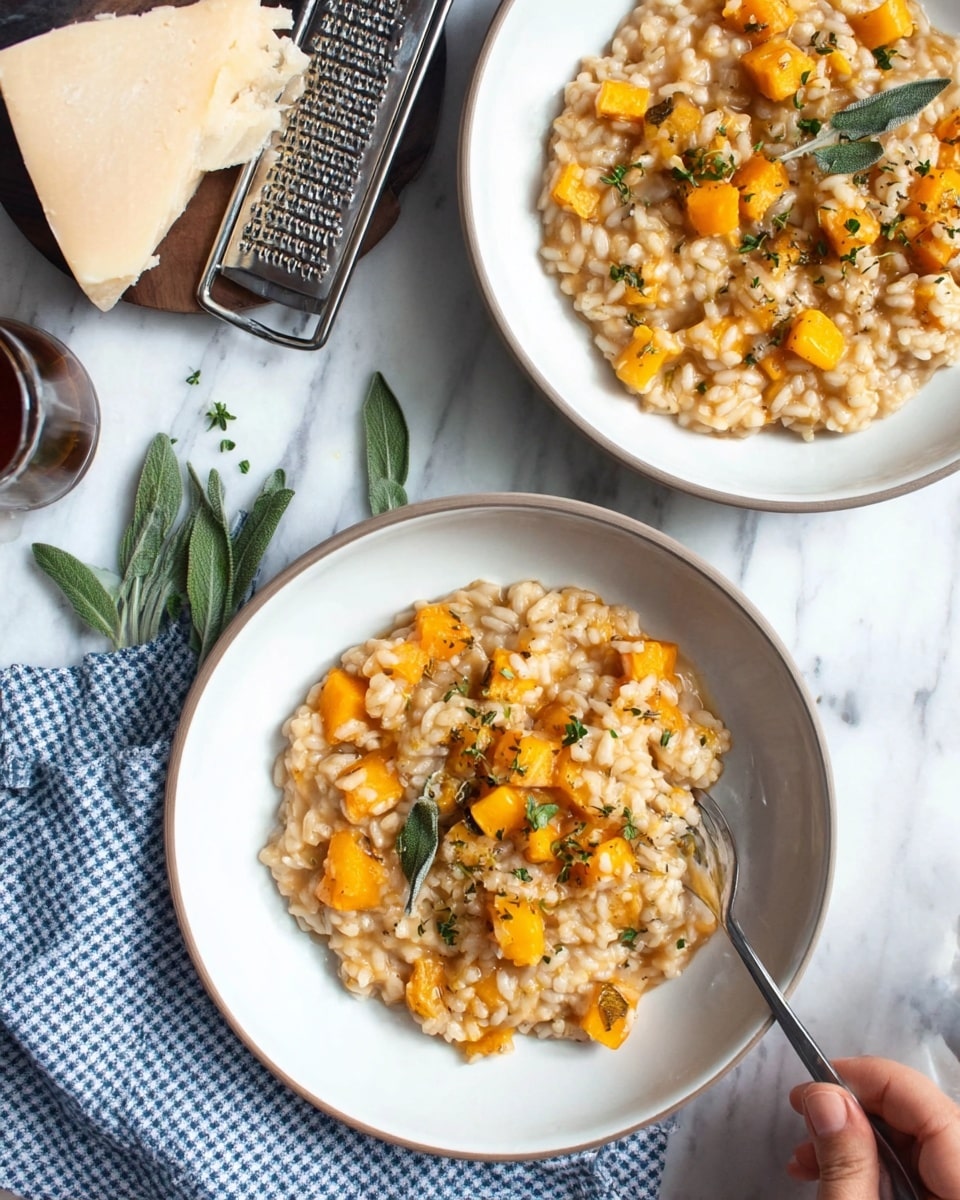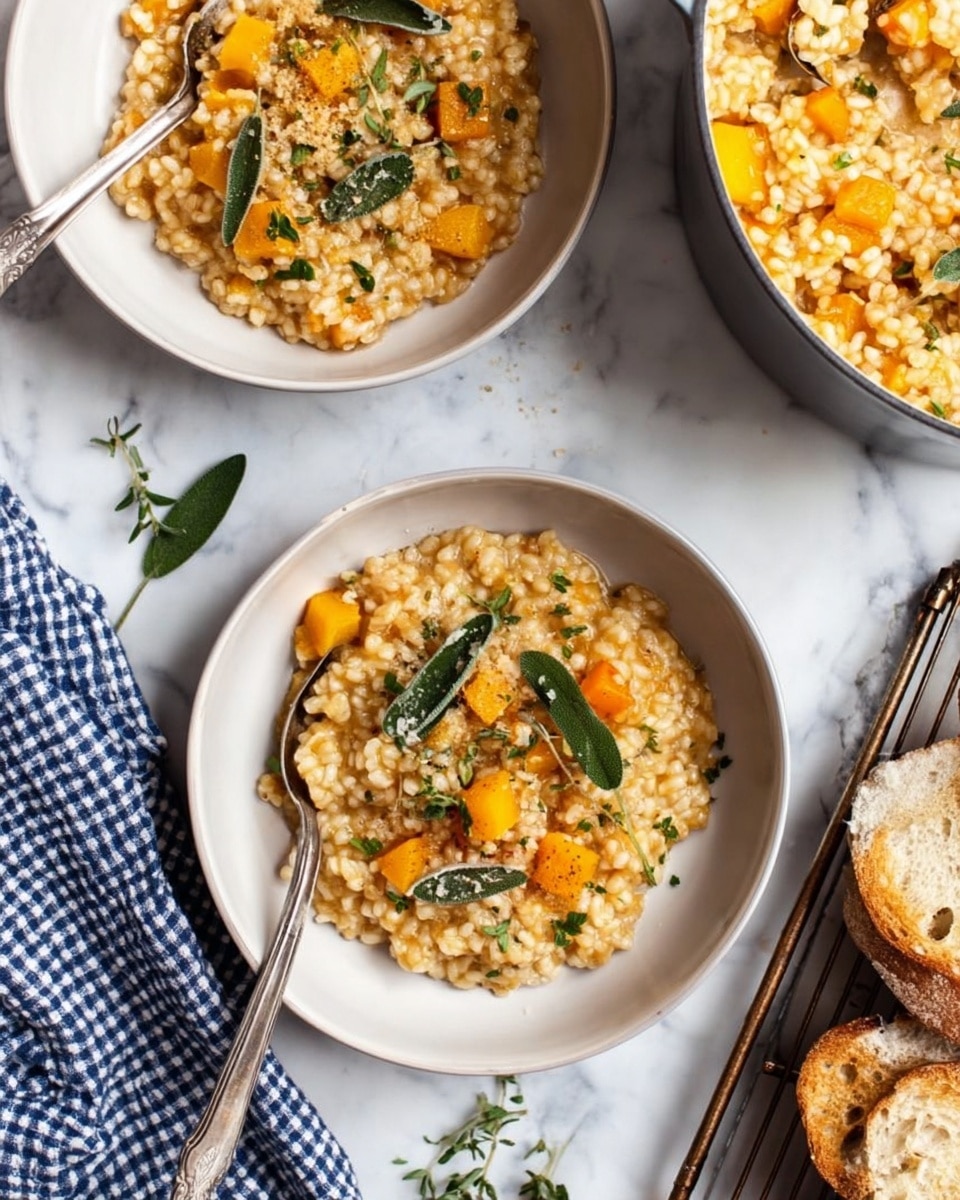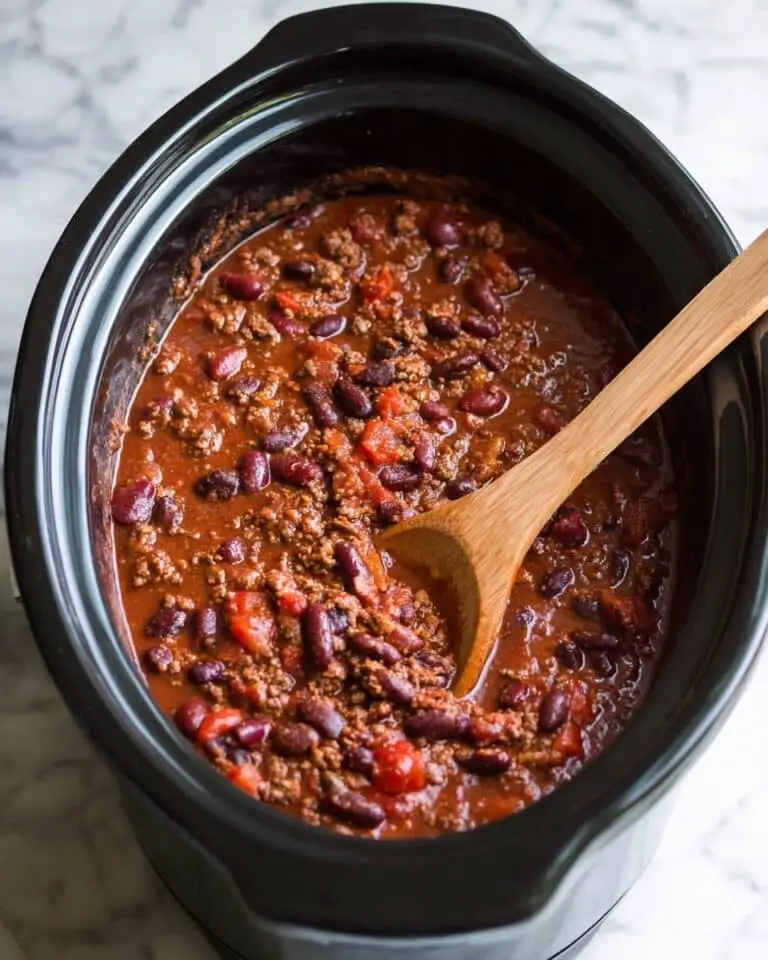I absolutely love this Butternut Squash Risotto Recipe because it brings together the comforting creaminess of a classic risotto with the subtle sweetness and earthy flavor of roasted butternut squash. It’s the kind of dish that feels fancy enough for guests but easy enough for a weeknight dinner. When I first tried making risotto with butternut squash, I discovered how effortlessly the squash tempers the rich, cheesy texture, creating a well-balanced plate that’s truly memorable.
You’ll find that this Butternut Squash Risotto Recipe works beautifully in fall when squash is at its peak, but honestly, it’s such a cozy dish that I make it anytime I want a warm hug on a plate. It’s also wonderfully adaptable, so whether you’re cooking for family or prepping a romantic dinner for two, it hits the spot every time.
Why You’ll Love This Recipe
- Comforting and Creamy: The risotto’s rich texture balances perfectly with sweet butternut squash for an indulgent yet wholesome meal.
- Simple Ingredients: You probably already have most of what you need in your pantry, making this recipe easy to whip up anytime.
- Flexible and Versatile: Adds lovely depth with herbs like rosemary or sage, and optional cheese makes it special.
- Great for Any Occasion: Impress dinner guests without fuss or enjoy a cozy solo treat.
Ingredients You’ll Need
Each ingredient in this Butternut Squash Risotto Recipe plays a key role in layering flavor and texture. Choosing quality staples and knowing a few tricks will really help you bring it all together flawlessly.
- Extra-virgin olive oil: I prefer a good quality one for that fruity, rich base flavor that makes the aroma pop as you soften the onions.
- Yellow onion: Sweet and mild, it builds a gentle foundation without overpowering the squash.
- Sea salt: I use it sparingly at first—you can always add more later as the flavors develop.
- Freshly ground black pepper: Fresh grind here adds a bit of punch and warmth to balance the sweetness.
- Butternut squash: Cut into small, even cubes so they cook evenly and tenderize just right — I like about ¼-inch pieces.
- Garlic cloves: Finely chopped garlic weaves in subtle savory notes without stealing the focus.
- Minced rosemary or sage: Fresh herbs are a must here – they add an aromatic earthiness that turns the risotto next-level.
- Arborio rice: The star of the risotto world. Its high starch content creates that luscious, creamy texture.
- Dry white wine: This adds acidity and complexity. If you’re not into wine, some lemon juice or extra broth works too.
- Vegetable broth: Warmed ahead of time to keep the cooking process smooth and speeds up absorption.
- Chopped parsley or small sage leaves (optional): For a burst of fresh color and aroma at serving time.
- Grated pecorino or Parmesan cheese (optional): Because sometimes more cheese is the answer—and it melts beautifully into the risotto.
Variations
I like to keep this Butternut Squash Risotto Recipe pretty classic, but sometimes I switch things up depending on the season or what’s in my fridge. It’s easy to make it your own.
- Herbs swap: I’ve used thyme instead of rosemary before, which adds a lovely minty note that pairs wonderfully with the squash.
- Cheese alternatives: Pecorino Romano gives a saltier punch compared to Parmesan, which I find adds a bit more dimension.
- Vegan version: Simply skip the cheese or use a plant-based substitute and make sure your broth is vegan-friendly—still just as tasty and creamy!
- Adding protein: Sometimes I toss in some toasted walnuts or crispy sage leaves for texture, or a bit of cooked chicken to stretch it into a full meal.
How to Make Butternut Squash Risotto Recipe
Step 1: Sauté Onions and Squash
Heat a tablespoon of extra-virgin olive oil over medium heat in a large skillet. Add the chopped onion with half a teaspoon of sea salt and a few grinds of black pepper. Stir occasionally and cook for 2–3 minutes until the onion starts to soften and smell sweet. Then add the cubed butternut squash and cook for another 6–8 minutes. You want the squash tender but still holding its shape — it should have a bit of bite when you bite into it. This step builds the foundational flavors, so don’t rush it!
Step 2: Add Garlic, Herbs, and Rice
Stir in the finely chopped garlic along with your minced rosemary or sage. Let this cook for about 30 seconds so the garlic and herbs release their fragrance without browning. Then add the Arborio rice and stir well. Let the rice toast lightly for about a minute—it should smell nutty. This little toasting step helps the rice absorb liquids evenly.
Step 3: Deglaze with Wine
Pour in half a cup of dry white wine and stir to deglaze the pan, scraping up any browned bits. Cook for 1–3 minutes until most of the wine has evaporated, which concentrates the flavor while adding a subtle acidity. If you don’t use wine, you can skip this and use a splash of broth instead, though I recommend wine for the depth it adds.
Step 4: Slowly Add Broth and Stir
Here’s where the magic happens. Add warmed vegetable broth about ¾ cup at a time, stirring continuously. Wait until the liquid is mostly absorbed before adding the next ladle. This slow absorption coaxed out the starches in the Arborio rice, turning it creamy and luscious. It usually takes around 30 minutes. Keep tasting—when the risotto is soft but still has a slight bite and the butternut squash feels tender, you’re good.
Step 5: Finish and Season
Give the risotto a final taste and season with additional salt and pepper if needed. If you want, stir in grated Parmesan or pecorino cheese right at the end for extra richness. Garnish with chopped parsley or small sage leaves to bring a fresh herbal lift.
Pro Tips for Making Butternut Squash Risotto Recipe
- Keep Broth Warm: I always keep my broth warm in a separate pot to prevent the risotto from cooling down and messing up the cooking process.
- Consistent Stirring: Stirring gently and constantly helps release the rice starch, making your risotto perfectly creamy.
- Small Squash Cubes: Cutting the butternut squash into small, uniform cubes ensures even cooking and a lovely creamy texture throughout.
- Don’t Rush Adding Broth: Patience is key—wait until the liquid almost completely absorbs before adding more broth to avoid mushy rice.
How to Serve Butternut Squash Risotto Recipe

Garnishes
I like to finish this risotto with a sprinkle of freshly chopped parsley or a few fresh sage leaves. It adds a pop of color and fresh aroma that balances the richness. When I’m feeling indulgent, a generous shaving or grating of Parmesan cheese over the top takes it to the next level.
Side Dishes
This Butternut Squash Risotto Recipe shines as a main dish, but if you want side ideas, I often serve it alongside a crisp green salad with tangy vinaigrette or roasted Brussels sprouts. A simple garlic sautéed kale also complements all the flavors beautifully without overwhelming the palate.
Creative Ways to Present
For a special dinner, I sometimes plate the risotto neatly using a ring mold for a clean, elegant look. Adding edible flowers or microgreens on top can impress guests and elevate this cozy dish into a beautiful centerpiece. A drizzle of balsamic glaze around the plate adds a modern twist that’s surprisingly delicious.
Make Ahead and Storage
Storing Leftovers
I store leftover risotto in an airtight container in the fridge, and it usually keeps well for up to 3 days. Because risotto thickens as it cools, it’s normal for leftovers to be denser than freshly made.
Freezing
Truthfully, I don’t recommend freezing risotto because the texture can change and become grainy. But if you must, freeze in portion-sized containers and thaw overnight in the fridge before reheating gently.
Reheating
To bring leftover risotto back to life, warm it slowly on the stove with a splash of broth or water, stirring to restore creaminess. You can also microwave it covered, adding a little liquid and stirring halfway through. Avoid overheating as it can dry out.
FAQs
-
Can I use butternut squash puree instead of cubes in this Butternut Squash Risotto Recipe?
You can, but cubed squash adds texture and slight sweetness as it softens during cooking. Puree will make it creamier but can also change the risotto’s consistency, potentially making it heavier. I recommend roasting the cubes for added flavor if you want to purée them first.
-
What type of rice is best for this risotto?
Arborio rice is ideal because of its high starch content, which gives risotto its signature creamy texture. Using other rice types might result in a less creamy or unevenly cooked dish.
-
Is it necessary to stir constantly when making the risotto?
While you don’t need to stir nonstop, frequent and gentle stirring helps release the rice’s starch gradually, ensuring that perfect creamy texture we all love in risotto.
-
Can I substitute vegetable broth with chicken broth?
Absolutely! Chicken broth adds a richer flavor, which complements the squash nicely. Just note it’s not vegetarian-friendly if that’s a concern.
-
How do I know when the risotto is done?
The rice should be tender but still have a slight bite (“al dente”), and the overall texture creamy—not dry or mushy. Also, the butternut squash should be soft and easily pierced with a fork.
Final Thoughts
This Butternut Squash Risotto Recipe has become one of my go-to meals when I want comfort food that feels a little special. I love how it combines simple ingredients into something that’s both cozy and elegant, perfect for sharing or savoring solo. Give it a try—you’ll see how versatile and forgiving risotto can be when paired with the sweet warmth of butternut squash. Plus, the hands-on stirring is strangely calming, almost like a little mindful cooking meditation. I hope you enjoy making and eating it as much as I do!
Print
Butternut Squash Risotto Recipe
- Prep Time: 15 minutes
- Cook Time: 40 minutes
- Total Time: 55 minutes
- Yield: 4 servings
- Category: Main Course
- Method: Stovetop
- Cuisine: Italian
- Diet: Vegetarian
Description
A creamy and comforting butternut squash risotto featuring tender squash, aromatic herbs, and Parmesan cheese, perfect for a cozy meal.
Ingredients
Main Ingredients
- 1 tablespoon extra-virgin olive oil
- 1 medium yellow onion, chopped
- 1/2 teaspoon sea salt, plus more to taste
- Freshly ground black pepper, to taste
- 2 cups cubed butternut squash, 1/4-inch cubes
- 2 garlic cloves, finely chopped
- 1 teaspoon minced rosemary or sage
- 1 cup uncooked Arborio rice
- 1/2 cup dry white wine
- 4 cups warmed vegetable broth
Garnish & Serving
- Chopped parsley or small sage leaves, optional, for garnish
- 1/2 cup grated pecorino or Parmesan cheese, optional, for serving
Instructions
- Heat Olive Oil and Sweat Onion: In a large skillet, heat 1 tablespoon of extra-virgin olive oil over medium heat. Add the chopped onion along with ½ teaspoon sea salt and several grinds of black pepper. Cook for 2 to 3 minutes until the onion becomes translucent and fragrant.
- Cook Butternut Squash: Add the 2 cups of cubed butternut squash to the skillet. Cook for 6 to 8 minutes, stirring occasionally, until the squash starts to soften but still holds its shape.
- Add Garlic, Herbs, and Rice: Stir in the finely chopped garlic and 1 teaspoon minced rosemary or sage. Then add 1 cup uncooked Arborio rice, stirring to coat the rice with oil and mix with the other ingredients. Let cook for about 1 minute to toast the rice lightly.
- Deglaze with Wine: Pour in ½ cup dry white wine. Stir the mixture continuously and cook for 1 to 3 minutes until the wine mostly evaporates and the rice absorbs the flavor.
- Incorporate Broth Gradually: Add 4 cups warmed vegetable broth a little at a time—about ¾ cup per addition. Stir continuously, waiting for each portion of broth to be absorbed before adding the next. Continue until the butternut squash is tender and the risotto is creamy and soft, about 20 to 25 minutes.
- Season and Finish: Taste and adjust seasoning with additional salt and pepper as needed. Remove from heat.
- Garnish and Serve: Serve the risotto hot, garnished with chopped parsley or small sage leaves if desired, and sprinkle with ½ cup grated pecorino or Parmesan cheese for a rich finish.
Notes
- You can substitute rosemary with sage or thyme based on your preference.
- Use warmed broth to ensure even cooking of the rice.
- Keep stirring continuously to prevent the risotto from sticking and to get a creamy texture.
- For a vegan version, omit the cheese or use a plant-based alternative.
- Leftovers can be stored in an airtight container in the refrigerator for up to 3 days.
Nutrition
- Serving Size: 1 cup
- Calories: 320
- Sugar: 4g
- Sodium: 450mg
- Fat: 8g
- Saturated Fat: 2g
- Unsaturated Fat: 6g
- Trans Fat: 0g
- Carbohydrates: 52g
- Fiber: 4g
- Protein: 8g
- Cholesterol: 8mg









